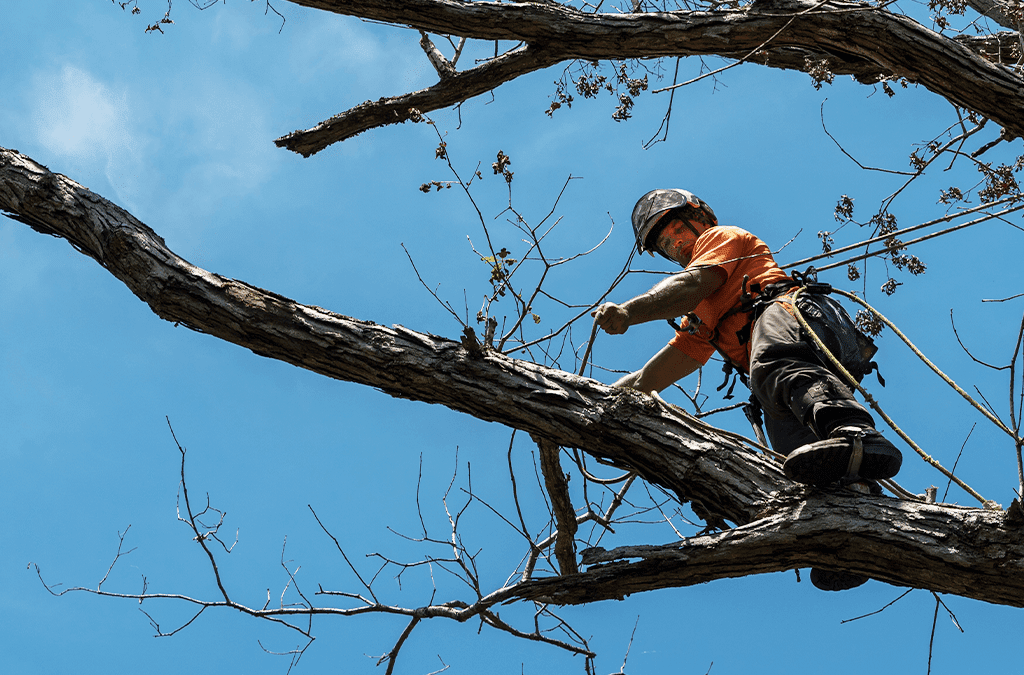A healthy tree in our yard does more good for us than we can imagine, but when it starts to show signs of decay, it becomes a major hazard. Sometimes a tree can be saved by pruning off the problem. Other times the whole thing needs to come down. So how do you tell if a tree needs to be removed? Assessment and removal is best left to a professional arborist, but here are signs that you should give them a call.

How Do You Tell If a Tree Needs To Be Removed
- Large Dead Branches: if you notice a branch is dead, hanging loose, or showing signs of weakness, you should contact your local tree trimmer. The limb may come down in the next storm, or it may indicate more significant decay that’s not visible.
- Fungi or Infections: look for crumbly wood, dieback, peeling bark, discolored leaves, or signs of mushrooms and other fungi. Some fungi don’t compromise the integrity of the tree, while others indicate internal rotting or major weakening of the trunk or root system.

- Split, Hollow, or Compromised Trunk: these signs indicate internal decay or structural problems in the tree. It can live with these issues for many years, which is why you see many hollow trees in an old growth forest. But in your backyard, they are at risk of falling.
- Root Defects: heaving soil or fungi near the base of your tree may be signs of root decay. Without a solid anchor in the ground, a tree won’t stand for long. Excavation near a tree can cause root damage, leading to a structural problem.

- A Leaning Tree: do you notice your tree leaning? The Tower of Pisa can handle a tilt, but your tree may be off-balance. Not all leaning trees are hazardous, so this is where an arborist assessment comes in handy.
- Your Tree Is Dead: did your tree fail to leaf out this year? It’s sad to say it, but it is almost certainly dead. Dead trees in a forest provide vital habitat for woodpeckers, owls, bats, and a whole society of insects and fungi. But in your yard, they could come tumbling down and do some damage.

Other Reasons to Remove Trees
We should strive to keep the trees alive on our property when we can. They provide shade for the backyard, shelter the house from the sun and cold wind, give us privacy, yield edible fruit and nuts, and make bird and squirrel habitats, among many other benefits. Yet, in some cases, they need to be removed, even when they’re healthy. Here are a few other common reasons to remove a tree:
- Too Close to a Structure: trees impinging on fences, powerlines, or houses may not pose a problem if pruned regularly, but if they risk causing damage, they can be removed altogether.
- Too Close to Each Other: perhaps the previous homeowners planted their maples too close together, or maybe you underestimated the spread of your oak. It’s possible to let crowded trees grow together in close contact, as they would in a forest. Or you can prune them regularly, or choose to sacrifice one so the other can flourish.
Trees take many years to grow, especially the grand maples and oaks that we love so much in Illinois. We can’t replace these giants instantly, which means we should think twice before cutting one down. Sometimes, of course, we don’t have a choice. But for every tree we cut down, we can plant another one or use the newfound sunlight to expand our garden.
To see your options for replanting or reshaping your garden, feel free to visit our garden centers in Carpentersville and Bloomingdale!
Platt Hill Nursery is Chicago’s premier garden center and nursery in the Chicagoland area.


